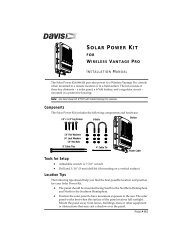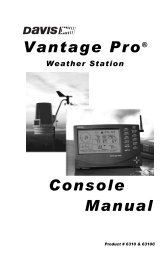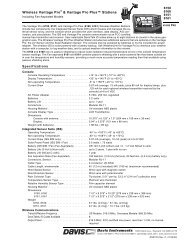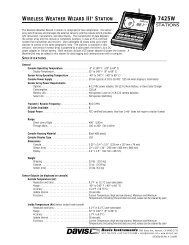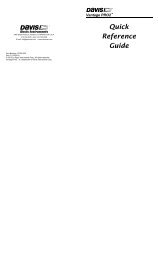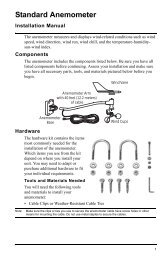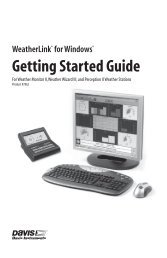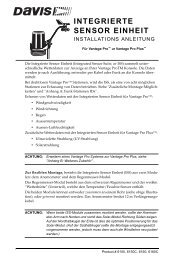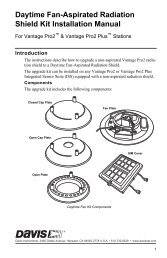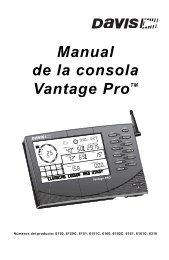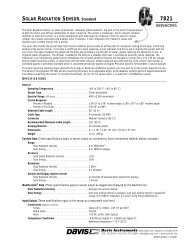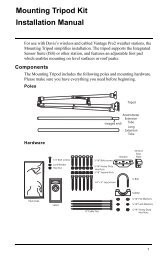Vantage Vue Integrated Sensor Suite Manual - Davis Instruments ...
Vantage Vue Integrated Sensor Suite Manual - Davis Instruments ...
Vantage Vue Integrated Sensor Suite Manual - Davis Instruments ...
Create successful ePaper yourself
Turn your PDF publications into a flip-book with our unique Google optimized e-Paper software.
<strong>Integrated</strong> <strong>Sensor</strong> <strong>Suite</strong>Installation <strong>Manual</strong>Model #6357®3465 Diablo Ave., Hayward, CA 94545 USA510.732.9229 • www.davisnet.com
Table of ContentsIntroduction ........................................................................................................1Included Components and Hardware .................................................................1<strong>Vantage</strong> <strong>Vue</strong> ISS Components ...............................................................1Hardware ................................................................................................2Tools Needed ..........................................................................................2Preparing the ISS for Installation .......................................................................2Attach the Wind Cups to the Anemometer ............................................3Attach the Wind Vane ............................................................................3Install the Rain Collector Tipping Spoon Assembly...............................4Install the Debris Screen .........................................................................4Install the Battery ...................................................................................4Advanced Installations: Confirm the Transmitter ID..............................5Advanced Installations: Set a New Transmitter ID.................................5Verify Data from the ISS ........................................................................6Installing the ISS ................................................................................................7Choosing a Location for the ISS ............................................................7ISS Installation Guidelines .....................................................................7Mounting the ISS.....................................................................................8Finishing the Installation ......................................................................10Maintenance and Troubleshooting ...................................................................11Appendix A: Specifications .............................................................................14FCC Part 15 Class B Registration WarningThis equipment has been tested and found to comply with the limits for a Class B digital device, pursuant to Part15 of the FCC Rules. These limits are designed to provide reasonable protection against harmful interference ina residential installation. This equipment generates, uses, and can radiate radio frequency energy and, if notinstalled and used in accordance with the instructions, may cause harmful interference to radio communications.However, there is no guarantee that interference will not occur in a particular installation. If this equipment doescause harmful interference to radio or television reception, which can be determined by turning the equipment onand off, the user is encouraged to try to correct the interference by one or more of the following measures:• Reorient or relocate the receiving antenna.• Increase the separation between the equipment and receiver.• Connect the equipment into an outlet on a circuit different from that to which the receiver is connected.• Consult the dealer or an experienced radio/TV technician for help.Changes or modification not expressly approved in writing by <strong>Davis</strong> <strong>Instruments</strong> may void the warranty and voidthe user's authority to operate this equipment.FCC ID: IR2DWW6357 IC: 3788A-6357EC EMC Compliance: This product complies with the essential protection requirements of the EC EMC Directive2004/108/EC; Low Voltage Directive 2006/95/EC; and Eco-Design Directive 2005/32/EC >.5 watt no-load adaptor.RoHS Compliant3465 Diablo Avenue, Hayward, CA 94545-2778 U.S.A.510-732-9229 • Fax: 510-732-9188E-mail: info@davisnet.com • www.davisnet.com®<strong>Integrated</strong> <strong>Sensor</strong> <strong>Suite</strong> Installation <strong>Manual</strong>.Rev. E, 4/30/12Document Part Number: 07395.262For <strong>Vantage</strong> <strong>Vue</strong> Weather Stations and Systems<strong>Vantage</strong> <strong>Vue</strong> ® , <strong>Vantage</strong> Pro2, and WeatherEnvoy are trademarks of <strong>Davis</strong> <strong>Instruments</strong> Corp.,Hayward, CA.© <strong>Davis</strong> <strong>Instruments</strong> Corp. 2012. All rights reserved.Information in this document subject to change withoutnotice. <strong>Davis</strong> <strong>Instruments</strong> Quality ManagementSystem is ISO 9001 certified.
IntroductionThe <strong>Vantage</strong> <strong>Vue</strong>® wireless <strong>Integrated</strong> <strong>Sensor</strong> <strong>Suite</strong> (ISS) collects outside weather dataand sends the data wirelessly to a <strong>Vantage</strong> <strong>Vue</strong> console via a low-power radio. The ISS issolar powered and includes a battery back-up.The <strong>Vantage</strong> <strong>Vue</strong> ISS contains a rain collector, temperature/humidity sensor,anemometer, and wind vane. The temperature/humidity sensor is mounted in a passiveradiation shield to minimize the impact of solar radiation on sensor readings. Theanemometer measures wind speed, and the wind vane measures wind direction.The <strong>Sensor</strong> Interface Module (SIM) is housed within the ISS and comprises the “brains”of the <strong>Vantage</strong> <strong>Vue</strong> system and the radio transmitter. The SIM collects outside weatherdata from the ISS sensors and transmits that data to your <strong>Vantage</strong> <strong>Vue</strong> console.Note:Your <strong>Vantage</strong> <strong>Vue</strong> ISS can transmit to an unlimited number of consoles, so you can purchase additionalconsoles to use in different rooms. It can also transmit to <strong>Davis</strong> <strong>Vantage</strong> Pro2 consoles and<strong>Davis</strong> Weather Envoys as well as <strong>Vantage</strong> <strong>Vue</strong> consoles.Included Components and Hardware<strong>Vantage</strong> <strong>Vue</strong> ISS ComponentsRain collectordebris screenWind cupsSolar panelRadiationshieldWind vaneTipping spoon(rain) assembly1
HardwareHardware included with the <strong>Vantage</strong> <strong>Vue</strong> ISS:U-BoltBattery cover withthumbscrew3-Volt lithium batteryBacking plate1/4” lock washers1/4” hex nutsDebris screen0.05” Allen wrenchNote:If any of the hardware components are missing or not included, contact Customer Service toll free at1-800-678-3669 about receiving replacement hardware or other components.Tools Needed• Adjustable wrench or 7/16” (11 mm) wrench• Compass or local area mapPreparing the ISS for InstallationFollow the steps in the order; each builds on tasks completed in previous steps.Note:Use a clean, well-lit work table or work area to prepare the ISS for installation.1. Attach the wind cups to the anemometer2. Attach the wind vane3. Install the rain collector tipping spoon assembly4. Install the debris screen in the rain collector5. Install the ISS battery to apply powerNote:At this point, we recommend that you set up your console, and then come back to finish the installation ofthe ISS. See your <strong>Vantage</strong> <strong>Vue</strong> Console <strong>Manual</strong>.Additional steps for advanced set up:• Verify transmitter ID• Change the transmitter ID for wireless communication, if necessary6. Verify data from the ISS2
Attach the Wind Cups to the AnemometerThe <strong>Vantage</strong> <strong>Vue</strong> anemometer measures wind speed. The wind cups are mounted on theanemometer shaft on the top of the ISS assembly.1. Gently slide the wind cup assemblydown onto the anemometer’sstainless steel shaft as far as it willgo, as shown.2. Use the Allen wrench provided totighten the set screw near the top ofthe “hub” section of the wind cups,as shown. Ensure that the set screwis screwed in fully and is tight.3. Pull gently on the hub to ensurethat the anemometer is securelyfastened to the shaft.4. Spin the wind cups to make surethey spin freely.Install cups ontostainless steel shaft.Tighten set screwwith Allen wrench.Note:If the wind cups don’t spin freely, loosen the set screw, remove them from the shaft, and repeat the windcup installation process.Attach the Wind VaneThe <strong>Vantage</strong> <strong>Vue</strong> wind vane measures wind direction. The wind vane is mounted on a stainlesssteel shaft on the opposite side of the ISS assembly from the wind cups.1. Hold the ISS assembly on its side withthe anemometer and radiation shieldson your left, the wind vane shaft onyour right and the wind cups awayfrom you.2. When the ISS is held in this manner,the wind vane shaft is horizontal, andwill orient itself so that its flat side willbe facing to the right, as shown.3. Holding the ISS assembly with yourleft hand, grasp the wind vane withyour right hand so that the “arrowhead”end is pointed down.4. Gently slide the wind vane onto the wind vane shaft, rotating the wind vane slightly left andright if necessary, until the end of the shaft is visible and protrudes slightly from the bottomsurface of the wind vane.5. Secure the wind vane to the shaft by firmly tightening the wind vane set screw with theAllen wrench provided.3
Install the Rain Collector Tipping SpoonAssembly1. Locate the tipping spoon assembly slot on theunderside of the ISS Base.2. Insert the wider end of the tipping spoon assemblyinto the slot first, sliding it under the raised lip of theslot.3. Fit the narrow end into the slot and tighten thethumbscrew securely.Tipping spoonassembly slotInstall the Debris ScreenThe <strong>Vantage</strong> <strong>Vue</strong> ISS rain collector debris screen capturesdebris that may otherwise clog your rain collector.1. Locate the small black plastic ISS debris screen in yourhardware package.The debris screen has four small tabs that hold it in placein the base of the rain collector.2. Holding the ISS assembly with one hand, and holding thedebris screen by the top, press it into the opening in therain collector until the tabs snap into the opening.Tipping spoonassemblyInstall the BatteryThe <strong>Vantage</strong> <strong>Vue</strong> ISS SIM board stores energy from the solar panel for power at night. A 3-volt lithium battery provides a backup power source. The battery compartment is located onthe underside of the ISS base. The compartment cover is included in the hardware packet.To install the ISS backup battery.1. Insert the 3-volt lithium battery intothe ISS battery compartment, beingsure to match the “+” sign on thebattery with the “+” sign embossedon the inside of the batterycompartment.2. Ensure that the battery is properly inplace, install the battery compartmentcover, and tighten the thumbscrew.Transmitter IDpushbuttonTransmitter IDLEDBatterycompartmentBattery compartmentcoverTo verify power, wait 30 secondsthen push and release the white transmitter ID pushbutton next to the battery compartment.The green transmitter ID LED next to the battery compartment will illuminate when youpress the pushbutton.Note:Press the pushbutton once and release it. Do not press it multiple times or hold it down.4
When you release the pushbutton, the LED will blink once (indicating transmitter ID 1),then begin to flash every 2.5 seconds to show transmission of a data packet. This flashingwill stop within a few minutes to conserve battery life.Note:If you have not already set up and powered your <strong>Vantage</strong> <strong>Vue</strong> console, do so before continuing with theISS installation. For best reception, the console and ISS should be at least 10 feet (3 meters) apart.3. The console acquires the radio signal and populates data fields. This usually occurs quickly,but in some enviromental conditions it can take up to 10 minutes.Advanced Installations: Confirm the Transmitter ID of the ISSYour <strong>Vantage</strong> <strong>Vue</strong> console can be used to listen to a <strong>Vantage</strong> Pro2 ISS instead of a <strong>Vantage</strong><strong>Vue</strong> ISS, and an optional anemometer transmitter kit.Note:If you are using only the <strong>Vantage</strong> <strong>Vue</strong> console and ISS, and there are no other <strong>Davis</strong> weather stationsnearby, you can skip to “Verify Data from the ISS” on page 6.In order to communicate, the console and ISSmust have the same transmitter ID. At thefactory, both IDs are set to a default of number1. To confirm the transmitter ID of your<strong>Vantage</strong> <strong>Vue</strong> ISS:1. Push and release the transmitter IDpushbutton once. It will illuminate and gooff when you release it.2. After a short pause, it will blink one ormore (up to 8) times. Note the number oftimes the transmitter ID LED blinks, indicatingits transmitter ID.Transmitter IDpushbuttonTransmitter IDLEDUnless you have intentionally changed your transmitter ID, the LED should blink one timebecause the default transmitter ID for the ISS is “1.” If you have changed the ID, the LEDshould blink the number of times equal to the ID you have set (i.e., twice for an ID of ‘2,’three times for an ID of ‘3,’ etc.).After blinking the transmitter ID, the light will begin to flash every 2.5 seconds, indicatingpacket transmission.Note:Note:The transmitter on the ISS and receiver on the console will communicate with each other only when bothare set to the same transmitter ID.If you hold the pushbutton too long and accidentally enter the “set new transmitter ID” mode when you didnot want to, simply release the pushbutton and wait four seconds. As long as you do not press the pushbuttonagain, the original transmitter ID will remain in effect.Advanced Installations: Set a New Transmitter ID on the ISSNote:In most cases, it will not be necessary to change the transmitter ID. If it is necessary to change the transmitterID, you must use the same ID for the ISS and console.The <strong>Vantage</strong> <strong>Vue</strong> ISS transmits weather information to the <strong>Vantage</strong> <strong>Vue</strong> console using one ofeight selectable transmitter IDs. The default transmitter ID for both the ISS and the <strong>Vantage</strong><strong>Vue</strong> console is 1. Change the transmitter ID if another <strong>Davis</strong> <strong>Instruments</strong> wireless weather stationis operating nearby and already uses transmitter ID 1, or if you have an optional Ane-5
mometer Transmitter Kit with ID 1.To set a new transmitter ID:1. Push and hold the transmitter ID pushbutton until the LED begins flashing quickly. Thisindicates it is in the setup mode.2. Release the pushbutton, and the LED will go dark.3. Push the pushbutton the number of times equal to your desired new transmitter ID. That is,if you want to change the ID to “3,” push the pushbutton three times; for a desired ID of“4,” push the pushbutton four times.After four seconds have elapsed with no further presses, the LED will blink the same numberof times as the new transmitter ID. (After blinking the transmitter ID number, the lightwill begin to flash each time a packet is transmitted, about every 2.5 seconds.)Verify Data from the ISSTo verify reception of ISS data by the <strong>Vantage</strong> <strong>Vue</strong> console, you will need your powered-upconsole and the ISS. For best reception, the console and ISS should be at least 10 feet (3meters) apart.1. If the console is in Setup Mode, press and hold DONE until the Current Weather screendisplays. The antenna icon appears under the wind compass rose. Watch this icon to seethat “transmission waves” appear, indicating reception of a packet.<strong>Sensor</strong> readings from the ISS should display on the screen within a few minutes.2. At the top right corner of the screen, look for the outside temperature.3. Gently spin the wind cups to check wind speed, pressing the WIND button on the consoleto alternate between speed and direction in the windcompass rose.4. Gently turn the wind vane, and allow 5 seconds for the wind direction display to stabilizebefore moving it again.Note:A good way to ensure that your console is listening to your ISS and not another <strong>Davis</strong> station nearby, is tomake sure the wind values displayed match your wind vane’s direction in reference to the solar panels,which are assumed to be facing south. For example, if you move the vane to point directly away from theISS, the console should show a wind direction of south; if you then turn the vane 180° so it is pointedback at the radiation shield, the wind direction on the console should change to north.5. Approximately one minute after acquisition of the signal, the outside relative humidityreading should be displayed on the console, below the outside temperature display.6. Confirm rain display. On your console screen, select the RAIN DAY display. (See <strong>Vantage</strong><strong>Vue</strong> Console <strong>Manual</strong>.). Carefully hold your ISS over a sink and, while watching the RAINDAY display on your console, slowly pour one-half cup of water into the Rain Collector.Wait two seconds to see if the display registers a rain reading.Note:This method confirms that the rain display is functioning. It cannot be used to verify accuracy.7. Current data displayed on the console confirms successful communication.Note:In some cases it may take as long as ten minutes for a reading to register on your console.If communication problems exist between the wireless ISS and the console, see“Troubleshooting ISS Reception” on page 12.6
Installing the ISSChoosing a Location for the ISSThe ISS assembly includes the rain collector, wind vane, anemometer, temperature andhumidity sensors, radiation shield, and SIM housing. You will use the U-bolt and associatednuts and washers that are included with your ISS mounting hardware package to install the ISSon a pole. (See “Hardware” on page 2.)To ensure that the <strong>Vantage</strong> <strong>Vue</strong> weather station performs at its best, use these guidelines toselect the optimum mounting location for the ISS. Be sure to take into consideration ease ofaccess for maintenance and wireless transmission range when siting the station.Note:When selecting a location for installing your ISS, especially on a rooftop, make sure it is a location farfrom power lines. Seek professional help if you are uncertain about the safety of your installation.ISS Installation GuidelinesNote:These siting guidelines reflect an ideal condition. Rarely is it possible to create the perfect installation.The better the siting, the more accurate your data will be.• Place the ISS away from sources of heat such as chimneys, heaters, air conditioners andexhaust vents.• Place the ISS at least 100' (30 m) away from any asphalt or concrete roadway that readilyabsorbs and radiates heat from the sun. Avoid installations near fences or sides of buildingsthat receive a lot of sun during the day.• Install the ISS as level as possible to ensure accurate rain and wind measurements. Use thebuilt in bubble level on the top of the ISS, just above the solar panel, to make sure the ISSis level.• In the Northern Hemisphere, the solar panel should face south for maximum sun exposure.• In the Southern Hemisphere, the solar panel should face north for maximum sun exposure.SOUTH(in the NorthernHemisphere)NORTH(in the SouthernHemisphere)Solar PanelNote:If you install the ISS with the solar panel pointing in a direction other than south, you will need to use thewind direction calibration function in the <strong>Vantage</strong> <strong>Vue</strong> console in order to obtain accurate wind directionreadings. See <strong>Vantage</strong> <strong>Vue</strong> Console <strong>Manual</strong> for more information.7
ISS Installation Guidelines• Ideally, mount the ISS so that it is between 5’ (1.5 m) and 7’ (2.1 m) above the ground inthe middle of a gently sloping or flat, regularly mowed grassy or naturally landscaped areathat drains well when it rains. You can also mount the ISS on the roof, between 5’ (1.5 m)and 7’ (2.1 m) above the roof surface. For areas with average maximum yearly snowdepths over 3’ (0.9 m), mount the ISS at least 2’ (0.6 m) above this depth.• Never install the ISS where it will be directly sprayed by a sprinkler system.• Avoid installations near bodies of water such as swimming pools or ponds.• Do not locate the ISS under tree canopies or near the sides of buildings that create “rainshadows.” For heavily forested areas, site the ISS in a clearing or meadow.• Site the ISS in a location with good sun exposure throughout the day.• For agricultural applications:• Install the ISS so that it is between 5’ (1.5 m) and 7’ (2.1 m) above the ground and inthe middle of the farm between similar crop types (ie. two orchards, two vineyards,or two row crops), if possible.• Avoid areas exposed to extensive or frequent applications of agricultural chemicals(which can degrade the sensors).• Avoid installation over bare soils. The ISS performs best when installed over wellirrigated,regularly mowed grass• If the last three guidelines cannot be met, install the ISS at the edge of the primarycrop of interest.Siting guidelines that may affect the anemometer• For optimal wind data, mount the ISS so that the wind cups are at least 7’ (2.1 m) aboveobstructions such as trees or buildings that may obstruct wind flow.• For optimal wind data, you may mount the ISS on a roof, keeping in mind ease of accessto the ISS for maintenance and safety considerations. Ideally, mount it so that the windcups are at least 7’ (2.1 m) above the roof apex.• The standard for meteorological and aviation applications is to place the anemometer 33’(10 m) above the ground. Seek professional help for this such installation.• The standard for agricultural applications is to place the wind cups 6’ (2 m) above theground. This is important for evapotranspiration (ET) calculations.Note:Note:For roof mounting, and ease of installation, we recommend using the optional tripod (#7716). For otherinstallations, use the Mounting Pole Kit (#7717).For more detailed siting suggestions, see Application Note #30 on the <strong>Davis</strong> Support website (http://www.davisnet.com/support/weather).Mounting the ISSThe <strong>Vantage</strong> <strong>Vue</strong> ISS can only be mounted on the top of a pole or rod.Note:A mounting pole is not included with your <strong>Vantage</strong> <strong>Vue</strong> ISS and must be purchased separately, eitherfrom <strong>Davis</strong> <strong>Instruments</strong> or from your local hardware retailer.8
ISS Installation GuidelinesRecommended Accessories for Pole Mounting• Use the Mounting Tripod (#7716) for easiest mounting.• Use the Mounting Pole Kit (#7717) to raise the installation height of the ISS by up to37.5" (0.95 m).General Guidelines for Installing on a Pole• With the supplied U-bolt, the ISS can be mounted on a pole or rod having an outsidediameter ranging from 1" to 1.75" (25 – 44 mm).• To mount on a smaller pole, obtain a U-bolt that fits the base openings but that has a longerthreaded section. If mounting the ISS on a smaller pole with the included U-bolt, thethreaded sections of the U-bolt will be too short to securely mount the ISS.C-shapedbracketInstalling the ISS on a Pole1. If you are mounting your ISS on a <strong>Davis</strong> Mounting Tripod or the pole included with a<strong>Davis</strong> Mounting Pole Kit, follow the instructions included with those <strong>Davis</strong> products forproper installation.If you are not using one of these <strong>Davis</strong> products, mount on a galvanized steel pole havingan outside diameter ranging from 1" to 1.75" (25 – 44 mm).Note:It is important that the mounting pole be plumb. You may wish to use a level such as a magnetic ”torpedolevel” to assure that the ISS, when mounted on top of the pole, will be level.2. Using the illustration above as a guide, hold the ISS so that the wind cups and radiationshield are on the left and gently place the ISS on top of the pole.3. While holding the mounting base of the ISS against the pole, place the two ends of the U-bolt around the pole and through the two holes in the C-shaped bracket on the base.4. Slide the metal backing plate over the bolt ends where they extend out from the far side ofthe bracket.5. Secure the backing plate with a lock washer and hex nut on each of the bolt ends, as shownin the illustration.6. Tighten the hex nuts with your fingers only so that the ISS is just secure enough on thepole for you to release your grip.9
ISS Installation Guidelines7. If you are in the Northern Hemisphere, rotate the ISS on the pole so that the solar panel isfacing south; if you are in the Southern Hemisphere, rotate the ISS so that the solar panel isfacing north. The more precisely the solar panels face due south or north, the more accurateyour wind direction readings will be.Note:Do not rely on a compass unless it is properly calibrated. In North America there can be up to 15° variationbetween true north and a raw compass reading.8. When the ISS is properly oriented, tighten the hex nuts with a wrench. Do not exceed 96inch-pounds (10.8 newton-meters) of torque.Note:You can refer to the bubble level on the top of the ISS to make sure it is as level as possible.Finishing the InstallationThe wind vane is calibrated at the factory to be accurate when the solar panel is pointing south.If your solar panel does not point south, you must calibrate your console so that it displaysaccurate wind direction readings. In any case, you can also calibrate your console to fine-tuneyour station for greatest accuracy. Refer to your <strong>Vantage</strong> <strong>Vue</strong> Console <strong>Manual</strong> to calibrate yourconsole.Note:Calibration must be done if you are in the Southern Hemisphere, or if you are in the Northern Hemisphereand cannot install your ISS with the solar panel facing south.Clearing Data Collected During Testing and InstallationNow that the ISS is mounted outside, any data that was collected and stored in the consoleduring testing and mounting should be cleared.To clear all the collected data on the console:1. On the console, press WIND so that selection arrow appears adjacent to the wind data onthe display. Confirm that wind speed is displayed on the compass rose.2. Press 2ND, then press and hold CLEAR for at least six seconds and until you see“CLEARING NOW” in the weather center.10
Maintenance and TroubleshootingMaintenanceCleaning the Radiation ShieldThe outer surface of the radiation shield should be cleaned when there is excessive dirt andbuild-up on the plates. Use a damp cloth to clean the outer edge of each ring.Note:Spraying down or using water excessively to clean the radiation shield can damage the sensitive sensorsor alter the data the ISS is transmitting.Check the radiation shield for debris or insect nests atleast once a year and clean when necessary. A buildupof material inside the shield reduces its effectivenessand may cause inaccurate temperature and humidityreadings.1. Using a Phillips head screwdriver, loosen the two#6 x 2 1 / 2 ” screws holding the five radiation shieldplates together, as shown.2. Taking care to maintain the order in which the fiveplates are assembled, separate the plates as shownand remove all debris from inside the shield.3. Reassemble the plates in the same order in whichthey were disassembled, and fasten them togetherusing a Phillips head screwdriver to tighten the #6x 2 1 / 2 ” screws, as shown.Solid plates,drain holestowardmounting poleCleaning the Rain Collector, DebrisScreen, and Tipping Spoon ModuleTo maintain accuracy, thoroughly clean the rain collector cone and debris screen as needed orat least once a year.Note:Cleaning the rain collector and tipping spoon may cause false rain readings. See “Clearing Data CollectedDuring Testing and Installation” on page 10.1. Use a damp, soft cloth to remove any debris from the rain collector and debris screen.2. Use pipe cleaners to clear any debris remaining in the screen.3. When all parts are clean, rinse with clear water.To clean the tipping spoon assembly, it must first be removed from the ISS base.11
Troubleshooting1. Unscrew the thumbscrew securing the tipping spoonassembly to the ISS base. Slide the assembly down andaway from the base.2. Use a damp, soft cloth to gently remove any debris fromthe tipping spoon assembly, being careful not to damageany moving parts or scratch the spoon.3. When all parts are clean, rinse with clear water, andreplace the assembly. (See “Install the Rain CollectorTipping Spoon Assembly” on page 4.)TroubleshootingTroubleshooting ISS ReceptionIf the console isn’t displaying data from the ISS:1. Verify that the ISS and console are powered and that the console is not in Setup Mode. (See<strong>Vantage</strong> <strong>Vue</strong> Console <strong>Manual</strong>.)2. Make sure that the ISS battery is properly installed.3. Walk around the room with the console, standing for a few moments in various locations, tosee if you are picking up signals from the ISS. Look on the screen below the wind compassrose for the small graphic of a radio antenna.Note:If you do not see the antenna icon, press 2ND and SETUP to enter Setup Mode, then press DONE toreturn to the Current Weather Screen. The icon should appear.Note:4. Small “transmission waves” display above the antenna icon and toggle on and off when theconsole receives a transmission.If you do not see the antenna’s transmission wave graphic slowly blinking, regardless ofwhere you stand with the console, you should call Technical Support.5. If the Transmitter ID LED does not light after pressing the Transmitter Pushbutton, there isa problem with the ISS transmitter. Call Technical Support.6. If, after pressing the Transmitter Pushbutton, the Transmitter ID LED flashes every 2.5 seconds(indicating transmission) but your console isn’t picking up a signal anywhere in theroom, it could be related to one of the following causes:• You changed the ISS Transmitter ID at the ISS or console, but not at both.• Reception is being disrupted by frequency interference from outside sources, or the distanceand barriers are too great.Interference has to be strong to prevent the console from receiving a signal while in the same room as theISS.• There is a problem with the <strong>Vantage</strong> <strong>Vue</strong> console.7. If a problem with receiving the wireless transmission still exists, please contact TechnicalSupport.Note: See “Contacting <strong>Davis</strong> <strong>Instruments</strong>” on page 13.12
TroubleshootingNote:Problems Using Two Transmitting StationsA single <strong>Vantage</strong> <strong>Vue</strong> console can receive signals from one ISS, either a <strong>Vantage</strong> <strong>Vue</strong> or a<strong>Vantage</strong> Pro2 ISS, and an optional anemometer transmitter kit. Make sure the transmitter IDsare configured correctly. See your <strong>Vantage</strong> <strong>Vue</strong> Console <strong>Manual</strong> for information on configuringtransmitter IDs.Most Common Rain Collector Problem“My rain data seems too low.”If the rain collector seems to be under-reporting rainfall, clean the debris screen andtipping spoon module to clear out any debris.Most Common Anemometer Problems“The wind cups are spinning but my console displays 0 mph.”The wind cups may not be turning the shaft. Remove the cups from the anemometer byloosening the set screw. Put the cups back onto the shaft and make sure to slide themdown the shaft as far as possible. Retighten the set screw.“The wind cups don’t spin or don’t spin as fast as they should.”The anemometer may be located where wind is blocked by something, or there may befriction interfering with the cups’ rotation. Remove the wind cups by loosening the setscrew, and clear out any insects or debris which may be interfering with the cup rotation.Turn the shaft the cups rotate on. If it feels gritty or stiff, contact <strong>Davis</strong> TechnicalSupport.Do not lubricate the shaft or bearings in any way.“Readings aren’t what I expected them to be.”Comparing data from your ISS to measurements from TV, radio, newspapers, or aneighbor is NOT a valid method of verifying your readings. Readings can varyconsiderably over short distances. How you site the ISS and anemometer can also makea big difference. If you have questions, contact <strong>Davis</strong> Technical Support.Contacting <strong>Davis</strong> <strong>Instruments</strong>If you have questions about the ISS or <strong>Vantage</strong> <strong>Vue</strong> system, or encounter problems installingor operating the weather station, please contact <strong>Davis</strong> Technical Support.Note:Please do not return items to the factory for repair without prior authorization.(510) 732-7814 – Technical Support phone, Monday – Friday, 7:00 a.m. – 5:30 p.m. PacificTime.(510) 670-0589 – Technical Support Fax.support@davisnet.com – E-mail to Technical Support.info@davisnet.com – General e-mail.www.davisnet.com – Download manuals and specifications from the Support section. Watchfor FAQs and other updates. Subscribe to the e-newsletter.13
Appendix A: SpecificationsSee complete specifications for your <strong>Vantage</strong> <strong>Vue</strong> station on our website:www.davisnet.com<strong>Integrated</strong> <strong>Sensor</strong> <strong>Suite</strong> (ISS) SpecificationsOperating Temperature...................................-40° to +150°F (-40° to +65°C)Non-operating (Storage) Temperature ............-40° to +158°F (-40° to +70°C)Current Draw (ISS SIM only)...........................0.20 mA (average), 30 mA (peak) at 3.3VDCSolar Power Panel (ISS SIM) ..........................0.5 WattsBattery (ISS SIM)............................................CR-123 3-Volt Lithium cellBattery Life (3-Volt Lithium cell) ......................8 months without sunlight - greater than2 years depending on solar chargingWind Speed <strong>Sensor</strong> .......................................Wind cups with magnetic detectionWind Direction <strong>Sensor</strong> ...................................Wind vane with magnetic encoderRain Collector Type .......................................Tipping spoon, 0.01" per tip (0.2 mmwith metric rain cartridge, Part No.7345.319), 18.0 in 2 (116 cm 2 ) collectionareaTemperature <strong>Sensor</strong> Type ..............................PN Junction Silicon DiodeRelative Humidity <strong>Sensor</strong> Type .......................Film capacitor elementHousing Material.............................................UV-resistant ABS & ASA plasticUpdate Interval by <strong>Sensor</strong>WIND TEMPERATURE RAIN HUMIDITY BARBarometric PressureInside HumidityOutside HumidityDew PointRainfall AmountRain Storm AmountRain RateInside TemperatureOutside TemperatureHeat IndexWind ChillWind SpeedWind DirectionDirection of High Speed1 min.1 min.50 sec.10 sec.20 sec.20 sec.20 sec.1 min.10 sec.10 sec.10 sec.2.5 sec.2.5 sec.2.5 sec.14



